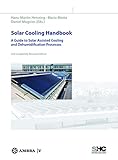Solar Cooling Handbook : A Guide to Solar Assisted Cooling and Dehumidification Processes / ed. by Daniel Mugnier, Hans-Martin Henning, Mario Motta.
Material type: TextPublisher: Berlin : Ambra Verlag, [2013]Copyright date: ©2013Description: 1 online resource (368 p.)Content type:
TextPublisher: Berlin : Ambra Verlag, [2013]Copyright date: ©2013Description: 1 online resource (368 p.)Content type: - 9783990434383
- 9783990434390
- 720 23
- online - DeGruyter
| Item type | Current library | Call number | URL | Status | Notes | Barcode | |
|---|---|---|---|---|---|---|---|
 eBook
eBook
|
Biblioteca "Angelicum" Pont. Univ. S.Tommaso d'Aquino Nuvola online | online - DeGruyter (Browse shelf(Opens below)) | Online access | Not for loan (Accesso limitato) | Accesso per gli utenti autorizzati / Access for authorized users | (dgr)9783990434390 |
Frontmatter -- Contents -- Preface -- Notes from the editors -- Chapter 1. Introduction -- Chapter 2. Meteorological data, heating and cooling loads and load sub-systems -- Chapter 3. Components of solar thermal systems -- Chapter 4. Heat driven cooling technologies: closed cycles -- Chapter 5. Heat driven cooling technologies: open cycle systems -- Chapter 6. Solar cooling system characterization -- Chapter 7. Energy and economic figures for solar cooling -- Chapter 8. Overall system design, sizing and design tools -- Chapter 9. Solar thermal system design -- Chapter 10. Pre-engineered systems: built examples and experiences -- Chapter 11. Experiences from installed custom made systems -- Chapter 12. DEC systems: built examples and experiences -- Chapter 13. Summary and outlook -- Chapter 14. Appendix
restricted access online access with authorization star
http://purl.org/coar/access_right/c_16ec
In vielen Ländern trägt die sommerliche Raumklimatisierung maßgeblich zum Energieverbrauch von Gebäuden bei. Eine vielversprechende Möglichkeit zur Reduktion ist die Nutzung von thermischer Solarenergie in Systemen der solar unterstützten Klimatisierung. Der große Vorteil liegt dabei in der weitgehenden Zeitgleichheit von Kühllasten und Solargewinnen, zumindest im saisonalen Maßstab. Allerdings wurden bis heute weltweit nur vergleichsweise wenige Systeme installiert, und es liegen nur geringe Erfahrungen hinsichtlich Auslegung und Betrieb solcher Anlagen vor. Das Ziel dieser mittlerweile in der 3. Auflage vorliegenden Handbuchs ist es, zur Beseitigung dieses Mangels beizutragen und den Planer bei der Auslegung von Anlagen der solar unterstützten Klimatisierung, die thermische Solarkollektoren als Wärmequelle nutzen, zu unterstützen.
Our energy system faces a fundamental transformation and renewable energies will play a dominant role in the future energy supply. One of the promising solutions is the use of solar thermal energy in buildings, for cooling, heating and domestic hot water preparation. Solar thermal systems for providing heat and cold to industrial processes show a high potential, too. In the last decade, the application of solar driven cooling systems achieved a significant progress. Steps forward have been taken in the design of system concepts to specific needs and in more reliable and efficient operation of the installed plants. New systems are available on the market and cover a broad range of cooling capacities and driving temperatures. This handbook provides an overview on the various solutions to convert solar heat into useful cooling, reports about experiences made with realized installations and gives support in the design process. Its use will strongly contribute to achieve high quality solar cooling systems which provide significant energy savings and fulfil the user’s requirements in a safe and reliable way.
Mode of access: Internet via World Wide Web.
In English.
Description based on online resource; title from PDF title page (publisher's Web site, viewed 29. Nov 2021)


